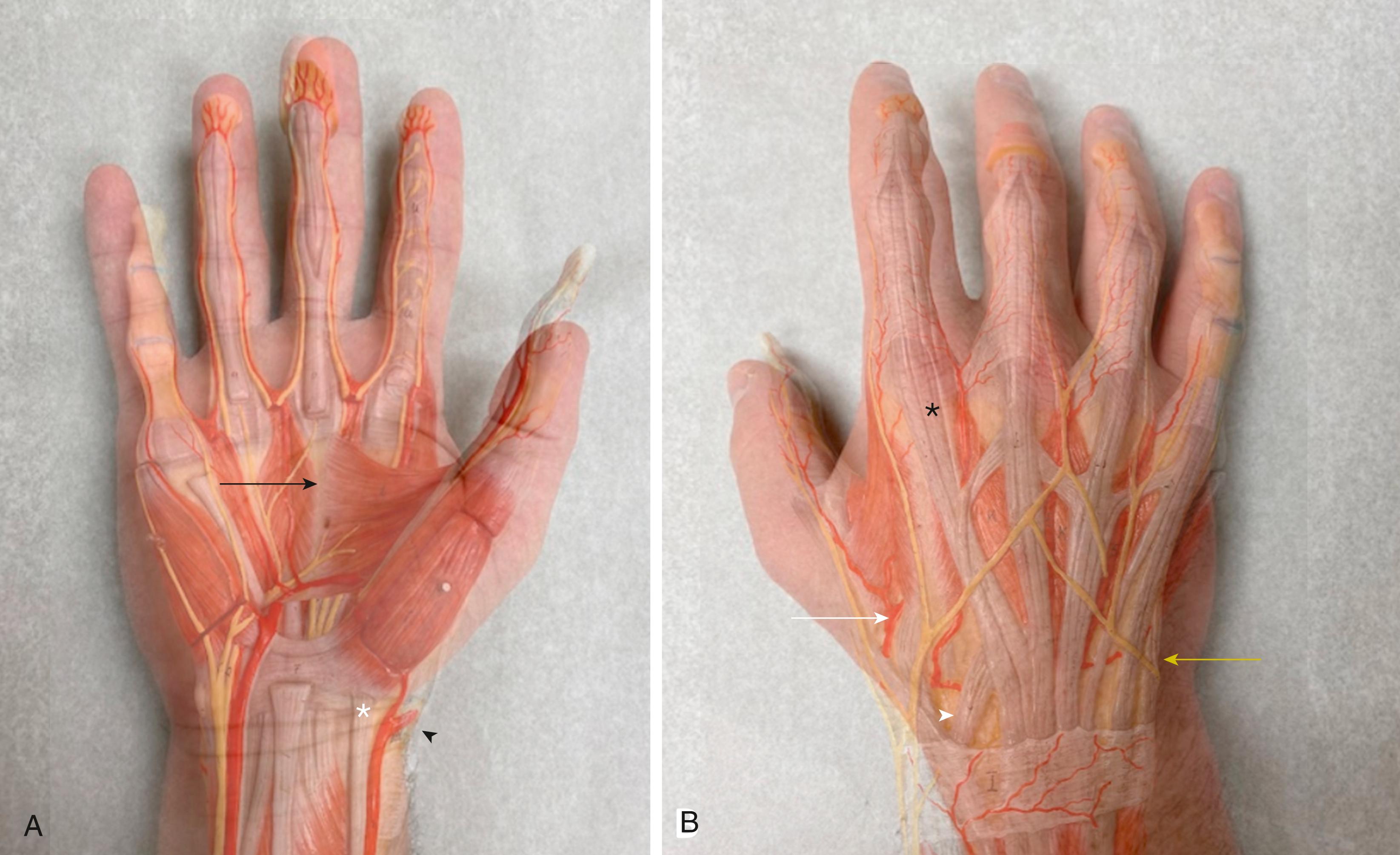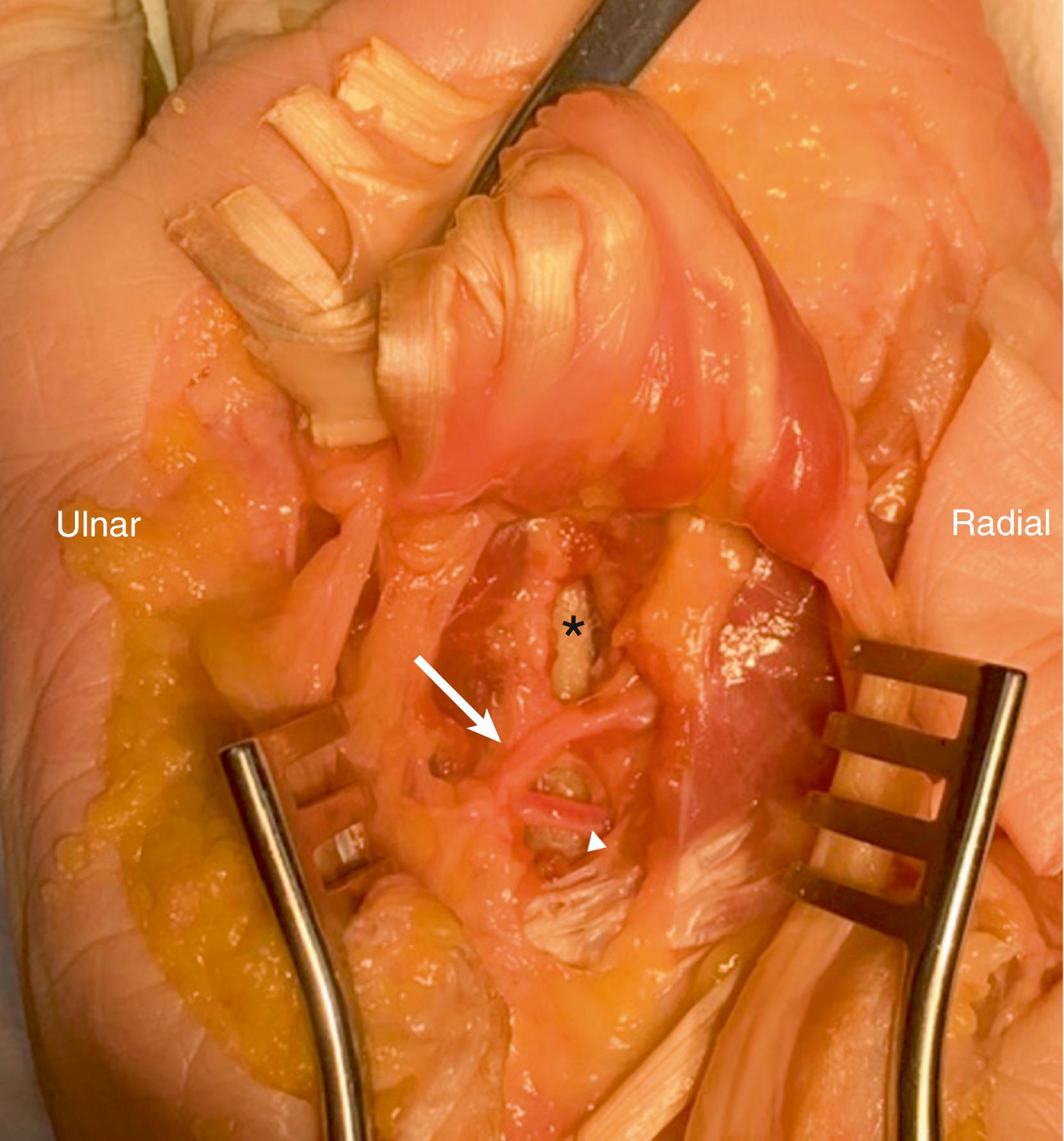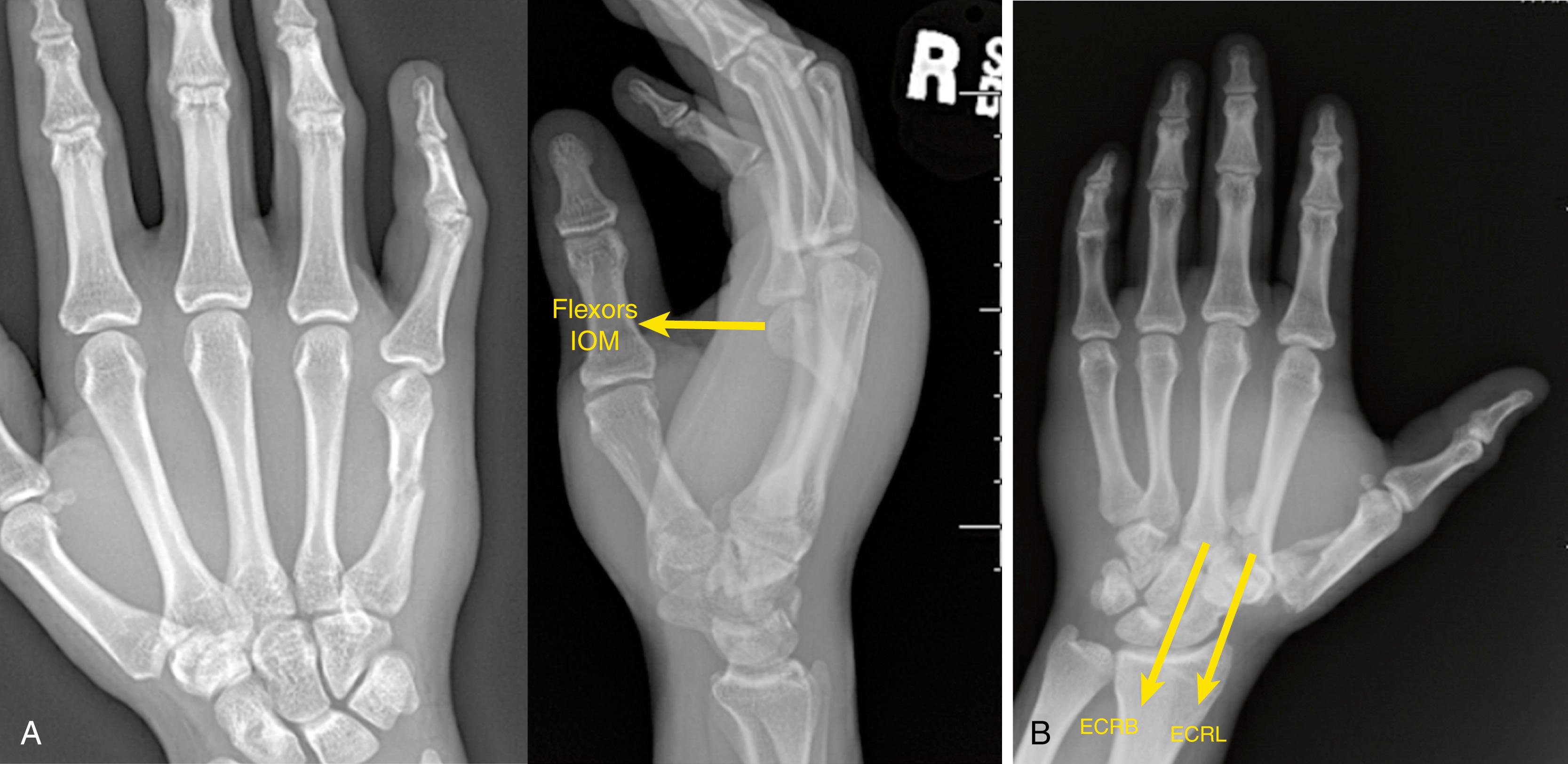Physical Address
304 North Cardinal St.
Dorchester Center, MA 02124
The metacarpal bones make up the bony arch connecting the phalanges to the carpus and are one of the most commonly fractured bone in the hand. Knowledge of the unique metacarpal anatomy, musculotendinous attachments, and surrounding neurovascular structures can allow surgeons to select the most effective and safe treatment individualized to each fracture. Several deforming forces act on the metacarpal head, neck, shaft, and base that lead to common patterns of displacement such as apex dorsal angulation and shortening. Special attention to thumb metacarpal base anatomy and common fracture patterns will lead to improved outcomes in these fractures. Nonoperative treatment is the mainstay for most metacarpal fractures, though many fixation options and approaches exist for fractures requiring surgical treatment. The ideal surgical treatment attains adequate alignment and stability while minimizing soft tissue disruption which can be accomplished with the use of percutaneous pinning, intramedullary devices, plates and screw constructs, and external fixators. When principles of metacarpal fracture management are followed, the outcomes are generally favorable with few complications. In this chapter, we will review the relevant anatomy, treatment options, surgical considerations, and outcomes of metacarpal fracture management.
The metacarpals are critical to the shape and function of the hand and serve as a framework to bridge the carpus to the phalanges. As the most proximal of the hand long bones, the metacarpals combine to form a concave arch in the palm. The bony anatomy can be divided into a head, neck, shaft, and base. The nonthumb metacarpals have a cam-shaped head that articulates with the proximal phalanx in a condyloid manner. This shape allows motion in flexion, extension, radial and ulnar planes. The metacarpophalangeal joint (MPJ) is stabilized by a fibrocartilaginous volar plate resisting hyperextension and a deep transverse intermetacarpal ligament connecting adjacent nonthumb metacarpals. This ligament, found approximately 2 cm proximal to the interdigital skin fold, is important in maintaining length stability in the setting of a more proximal isolated metacarpal fracture. The collateral ligaments provide varus and valgus stability to the MPJ. The proper collateral ligament travels at an angle of 30 degrees from the collateral recess dorsally on the metacarpal head to the proximal phalanx base. The accessory collateral ligament travels nearly perpendicular to the joint inserting on the volar plate. Testing the integrity of the proper and accessory collateral ligament can be performed at 30 degrees of MPJ flexion and full joint extension, respectively, to align with their anatomic orientation.
The nonthumb metacarpal shafts are triangular shaped with a flat dorsal surface that widens at the base. The fifth metacarpal has the widest medullary canal while the second metacarpal has the longest length and largest neck width. Conversely, the ring finger has the narrowest intramedullary canal which must be considered during intramedullary fixation , The coronal plane alignment of the ring and small finger metacarpals is essentially straight while the sagittal plane apex dorsal bow is 12 and 10 degrees, respectively. At their base, the metacarpals form a cuboidal shape and articulate with each other in addition to the distal carpal row. The mobility of the carpometacarpal (CMC) joints increases from radial to ulnar; the index and long finger CMC joints are more constrained with limited range of motion compared with the ring and small finger CMC joints with a much larger flexion-extension arc of motion. This allows powerful precision pinch and cupping of the hand. ,
The muscular anatomy of the palm includes the interosseous muscles, the lumbricals, the thenar muscles, and the hypothenar muscles. The extrinsic extensor tendons are stabilized over the MPJ by the radial and ulnar sagittal bands originating from the lateral margins of the volar plate. The interossei muscles originate along the volar radial and volar ulnar faces of the metacarpal shaft and travel distally passing dorsal to the deep transverse intermetacarpal ligament. This ligament is continuous with the interosseous muscular fascia. Innervated by the ulnar nerve, the bipennate dorsal interossei impart a flexion and abduction moment and the unipennate palmar interossei impart a flexion and adduction moment to the MPJ. The lumbricals originate from the flexor digitorum profundus (FDP) tendons in the palm and travel volar to the deep transverse intermetacarpal ligament along with the neurovascular bundles. The four lumbrical muscles insert onto the radial extensor expansion and contribute to MPJ flexion.
Several other extrinsic muscles insert at the level of the metacarpals and can be a deforming force in the setting of a metacarpal fracture. Dorsal tendon attachments include the extensor carpi radialis longus (ECRL) and extensor carpi radialis brevis (ECRB) onto the base of the second and third metacarpals, respectively. The extensor carpi ulnaris (ECU) inserts onto the base of the fifth metacarpal. Additionally, the extensor digitorum communis (EDC) tendon to the index, long, ring, and small fingers is central over the respective metacarpal and the extensor indicis proprius and extensor digiti minimi (EDM) are found deep and ulnar to the EDC of the index finger and small finger, respectively. On the volar aspect, the flexor carpi radialis (FCR) tendon inserts on the base of the index metacarpal and the flexor carpi ulnaris (FCU) inserts at the base of the small finger metacarpal, the pisiform, and the hook of the hamate. The adductor pollicis muscle, an important intrinsic muscle for pinch, comprises a transverse and oblique head that originates from the long finger metacarpal shaft and capitate, respectively. These two heads join to insert onto the ulnar thumb sesamoid, the base of the proximal phalanx, and the extensor apparatus ( Fig. 74.1 ).

The primary arterial supply to the hand originates from the radial and ulnar arteries. The radial artery branches into a dorsal branch and a volar branch at the level of the radial styloid. The dorsal branch crosses the anatomic snuffbox to then travel between the two heads of the first dorsal interosseous muscle and contribute to the deep palmar arch. Before penetrating the first dorsal interosseous muscle, this branch gives supply to the dorsal aspect of the thumb. The princeps pollicis arises from this contribution of the radial artery and supplies the palmar proper radial and ulnar digital arteries of the thumb and frequently the radial digital artery to the index finger. The volar branch contributes to the superficial arch. The ulnar artery gives a small branch to the deep palmar arch and predominantly contributes to the superficial arch. The superficial arch travels approximately 12 mm distal to the carpal tunnel with the deep palmar arch coursing more proximal. At the mid-level of the metacarpals, the common digital arteries to the second through fourth web spaces arise from the superficial arch and subsequently bifurcate at the level of the MPJ to become the proper digital arteries. The ulnar proper digital artery is dominant in the thumb and index finger. The radial proper digital artery is dominant in the ring and small finger.
The neuroanatomy of the hand comprises the median, ulnar, and radial nerves. At the level of the metacarpals, the median nerve exits the carpal tunnel to innervate the thenar musculature via the recurrent motor branch and the two most radial lumbricals via the common digital nerves. It courses dorsal to the common digital arteries to become the common digital nerves to the first, second, and third webspace. The ulnar nerve innervates the hypothenar musculature via the deep motor branch, the ulnar two lumbrical muscles, the adductor pollicis, and all of the interosseous muscles. The deep motor branch of the ulnar nerve and the deep palmar arch lie within close proximity to the volar surface of the metacarpal bones and are at risk of injury during fracture fixation, especially of the third metacarpal ( Fig. 74.2 ). Sensory innervation to the fourth web space, the small finger, and the dorsal ulnar hand occurs via the common digital nerve, the ulnar proper digital nerve to the small finger, and the dorsal cutaneous branch from the ulnar nerve. ,

The thumb is essential for normal hand function and its unique anatomy allows for prehension. The thumb metacarpal is a more cylindrical, shorter, and wider metacarpal and rests in a relative pronated position. , Distally, the MCP joint is a condyloid joint with a round, but less spherical head than the other metacarpals. The volar plate, proper collateral and accessory collateral ligaments function to stabilize this joint in a similar manner to the other digits. Proximally, the CMC joint is a biconcavoconvex joint with interlocking saddle shapes opposing one another and a notable beak at the volar metacarpal base. This anatomy allows abduction, adduction, flexion, extension, hitchhiker, circumduction, opposition, and the ability to transition from unstable to stable. There are 16 named ligaments around the CMC joint, the most important of these for pinch is the dorsal ligament complex (comprises the dorsal radial and posterior oblique subligaments). The volar beak ligament also contributes to joint stability predominantly in a hitchhiker position.
Important muscular and tendinous attachments to the thumb metacarpal act as dynamic stabilizers and potential deforming forces in trauma. The first dorsal interosseous muscle originates from the thumb metacarpal and inserts into the index finger extensor expansion to produce index finger abduction and thumb adduction. The abductor pollicis longus (APL) inserts onto the dorsal radial base of the thumb metacarpal. The extensor pollicis brevis and longus cross the thumb metacarpal to insert onto the proximal and distal phalanx, respectively. Other muscles important to thumb function include the intrinsic thenar muscles, the abductor pollicis brevis (APB), flexor pollicis brevis, and opponens pollicis. Of these, the opponens pollicis inserts onto the volar radial thumb metacarpal and the flexor pollicis brevis and APB insert on the thumb MPJ capsule and radial sesamoid. , ,
Metacarpal fractures are very common injuries affecting the hand and comprise up to 44% of all hand fractures. Fractures may be the result of a direct blow or axial loading. , An understanding of the relevant anatomy and the deforming forces is critical to effective nonoperative or operative treatment. In nonthumb metacarpal shaft fractures, the combined flexion moment on the metacarpal by the intrinsic muscles and strong extrinsic flexors typically leads to an apex dorsal angulation. The ECRL and ECRB can cause dorsal displacement of metacarpal base fractures involving the index and long finger, respectively ( Fig. 74.3 ). The ECU causes the typical deformity seen in a reverse Bennett fracture of proximal and ulnar displacement of the metacarpal shaft. Conversely, the intermetacarpal ligament imparts length stability to the nonthumb central metacarpals and prevents metacarpal shortening of >4 mm when fractured.

The deforming forces affecting the thumb are primarily the APL and the adductor pollicis. In thumb metacarpal base fractures, the Bennett or comminuted Rolando fractures, the APL pulls the metacarpal base proximal while the adductor pollicis pulls the distal fragment into flexion, adduction, and supination ( Fig. 74.4 ). , The ligamentous attachment to the palmar beak fragment in Bennett’s fractures is primarily the ulnar collateral ligament and to a lesser degree, the anterior oblique ligament.

Metacarpal head fractures, although rare, often involve small fragments or articular disruption and risk osteonecrosis with operative or nonoperative treatment. Metacarpal neck fractures can result from direct axial blows, as in the common “boxer’s fracture” involving the small finger. Often these injuries involve comminution of the volar metacarpal neck. , Typical apex dorsal angulation is seen just as in metacarpal shaft fractures. A “pseudoclaw” deformity may result from compensatory MPJ hyperextension and proximal interphalangeal (PIP) joint flexion due to an imbalance of extrinsic and intrinsic forces. Metacarpal shaft fractures may occur as transverse, oblique, or comminuted fractures depending on the mechanism of injury and are subject to angulation, rotation, and shortening. Metacarpal base fractures may occur as the result of a fall onto a flexed wrist with axial loading onto the metacarpal. , These fractures can present in conjunction with a CMC dislocation and may be intra-articular in nature. Injuries involving CMC fracture-dislocations are more commonly the result of a blow to a closed fist or involve high-energy mechanisms of injury such as a fall from height or motor vehicle accident. Due to the bony anatomy of the CMC articulation, the majority of fracture-dislocations displace dorsally despite the stout nature of the dorsal ligaments.
Become a Clinical Tree membership for Full access and enjoy Unlimited articles
If you are a member. Log in here